At the Beer Sheba Project in Senegal, Moringa oleifera is grown for both leaf and seed production. Managers of the moringa plots have tried different spacing options over time and would like to share their thoughts on the frequently asked question, “What spacing should I use for moringa?”.
The most important factor affecting the spacing of moringa trees is what you will use the tree for. If trees are used for leaf production for human or animal consumption, they can be planted close together. If they are planted for pod or seed production, whether for seed multiplication, vegetable pods, or oil production, they need to be planted farther apart. See table 3 for recommendations from the literature. These ranges vary due to soil type, water, inputs, harvest frequency, management practices and other on-farm considerations.
| Minimum | Maximum | |
|---|---|---|
| Leaves | 5 cm x 10 cm (Amaglo et al., 2006) | 50 cm x 100 cm (Leone et al., 2015 |
| Seeds and pods | 2.5 x 2.5 m (Kumar et al., 2014) 5 | 5 x 5 m (Emongor, 2011) |
| In agroforestry systems | 2 m between rows (Leone et al., 2015) | 4 m between rows (Leone et al., 2015) |
Leaves and stems
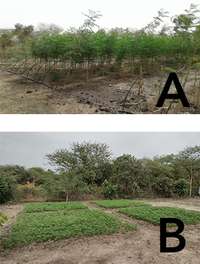
Figure 9. 1 x 1 m spacing (A) vs. four blocks of 4 x 4 m moringa intensive production (B). Source: Noah Elhardt
For leaf production, we initially direct-seeded 0.5 ha at 1 x 1 m spacing (Figure 9A). Tree survival rates were high and gave good harvests of leaves with lots of stems. After the second year, production lessened somewhat. At this wide spacing, managers of the plot spent a lot of time weeding.
We have since switched to intensive cultivation in 4 x 4 m blocks (Figure 9B), with plants spaced at 10 to 20 cm. These plantations need intensive inputs and regular reseeding and are highly productive. They also need very little weed management, and water and soil amendments are more easily and efficiently applied than in wider spacings.
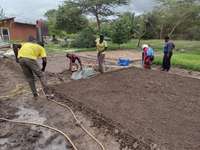
Figure 10. Complete bed ready for planting. Source: Noah Elhardt
To prepare for planting, we dig a 4 x 4 m bed to a depth of 50 cm. We add 15 sacks of chicken bedding, and then cover this amendment with the removed soil. We water the bed for 3 to 4 weeks, after which further soil is added to raise the plot to about 5 cm above ground level (Figure 10). After leveling it with a rake, we seed (one seed per hole) and mulch the plot. Emergence typically follows in 5 to 7 days. We water daily, with a weekly application of compost tea (liquid organic fertilizer). After each harvest, we reseed any missing plants and add two wheelbarrows of compost. Moringa regrows rapidly after being coppiced (cut back) during harvesting with several branches often emerging below the last cut. In this manner, we have had plots in production for three years, though there is a slight decrease in production after the first year (Figure 11). We have not had to re-establish plantings yet. When re-establishing you may have to completely remove moringa stems to keep old trees from re-sprouting. Beds could be rebuilt, and plantings re-seeded as explained earlier.
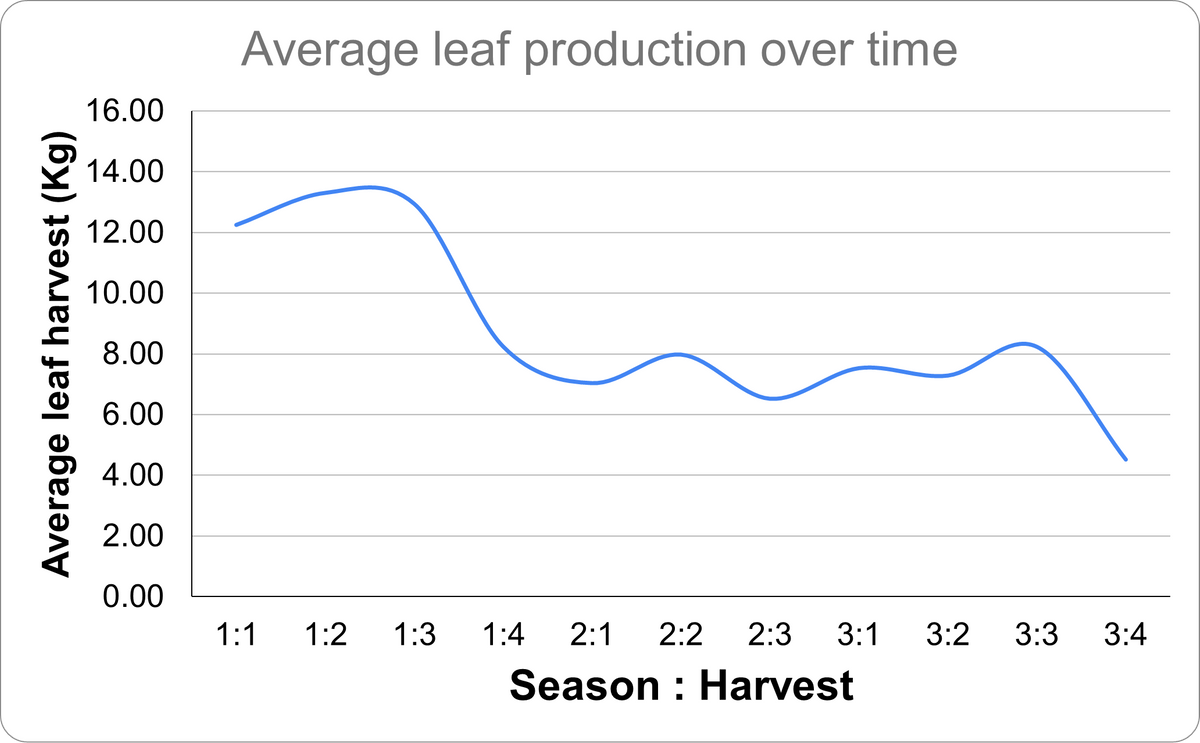
Figure 11. Average harvest in Kg of leaves per season and harvest. Source: Noah Elhardt
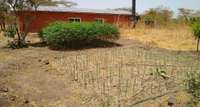
Figure 12. Cut vs. uncut moringa block. Source: Noah Elhardt
Here in Senegal, we harvest these blocks every 2 to 3 months during the dry season by cutting them about 10 to 15 cm above the ground (Figure 12). The average yield of fresh leaves across 204 harvests in the last two seasons was 9.3 kgs, or about 6 tons/ha. These same cuttings also produced 31 kgs of stems on average, which we use as high-protein livestock feed. We typically manage three to four cuttings in a dry season on each plot, before rainy season conditions in Senegal lead to a degradation in leaf quality. Plots are harvested during the rainy season to feed livestock and maintain plot health. We cut about one block per day so that we have a continuous supply of leaves to use or dry.
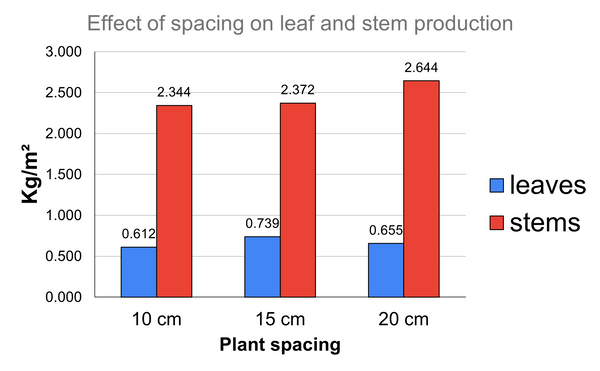
Figure 13. Spacing impact on stem and leaf production. Source: Noah Elhardt
In a recent trial, we planted six to eight intensive plots at each of three different grid spacings (with equal distance within and between rows): 10 cm, 15 cm, and 20 cm. Over five harvests, the plots spaced at 15 cm have shown the highest leaf production (Figure 13). The 20 cm spacing produced a higher ratio of stems to leaves. Most of our leaf production plots now use 15 cm spacing.
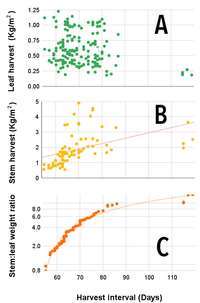
Figure 14. Impact of harvest time on leaf production (A), stem produciton (B), and stem:leaf ratio (C). Source: Noah Elhardt
Impact of harvest intervals
Minimizing spacing between moringa plants seems to increase the ratio of leaves to stems. The interval between harvests also has an impact.
Our harvest data from the last two seasons shows little correlation between harvest interval and the weight of fresh leaves produced (Figure 14A). Additional growth time beyond 60 days does not appear to increase leaf production at these close spacings.
However, the weight of harvested stems continues to increase with harvest interval (Figure 14B). The time between harvests strongly influenced the ratio of stems to leaves in our harvests (Figure 14C). The ideal harvest interval therefore depends on whether you have a need for leaves, stems, or both.
Seed production
For seed production, we grow trees on a 4 x 4 m grid, which seems to work well for us. We use the seeds for oil production and to reseed leaf production plots.
In the past, we had mixed fields with both coppiced (for leaf production) and uncoppiced (for seed production) trees. We found that the uncoppiced trees developed larger canopies and stronger root systems, outcompeting the smaller coppiced trees. These latter trees soon became unproductive, and we removed them. We recommend growing trees meant for leaf production separate from those intended for seed production.
Conclusion
Recommendations for moringa planting differ widely based on the moringa product being harvested as well as biogeographical region and agronomic practices. We highly recommend that you try different spacing options in small blocks first to determine what spacing works best for your region and your management preferences. Remember that moringa may do well during some seasons and not others (it typically loses leaves during rainy seasons). Another factor to consider is how frequently you cut the trees. Base this consideration on the local demand or use of the commodity you are growing. Your intended consumption and management resources will help narrow in on what spacing, and harvest frequency will be best for your context.
References
Amaglo, N.K., G.M. Timpo, W.O. Ellis, and R.N. Bennett. 2007. Effect of Spacing and Harvest Frequency on the Growth and Leaf Yield of Moringa (Moringa oleifera L.), a leafy Vegetable Crop. Moringa and other highly nutritious plant resources: Strategies, standards and market for a better impact on nutrition in Africa.
Basra, S.M.A., W. Nouman, Hafeez-ur-Rehman, M. Usman, and Z.H. Nazli. 2015. Biomass Production and Nutritional Composition of Moringa oleifera under different Cutting Frequencies and Planting Spacings. International Journal of Agriculture & Biology 17(5):1055-1060.
Emongor, V.E. 2011. Moringa (Moringa oleifera Lam.): a Review. Acta Horticulture, 911:497-508.
Kumar, A.R., M. Prabhu, V. Ponnuswami, V. Lakshmanan, and A. Nithyadevi. 2014. Scientific seed production techniques in Moringa. Agricultural Reviews, 35 (1):69-73.
Leone, A., A. Spada, A. Battezzati, A. Schiraldi, J. Aristil, and S. Bertoli. 2015. Cultivation, genetic, ethnopharmacology, phytochemistry and pharmacology of Moringa oleifera leaves: An Overview. International Journal of Molecular Sciences, 16(6):12791-12835.